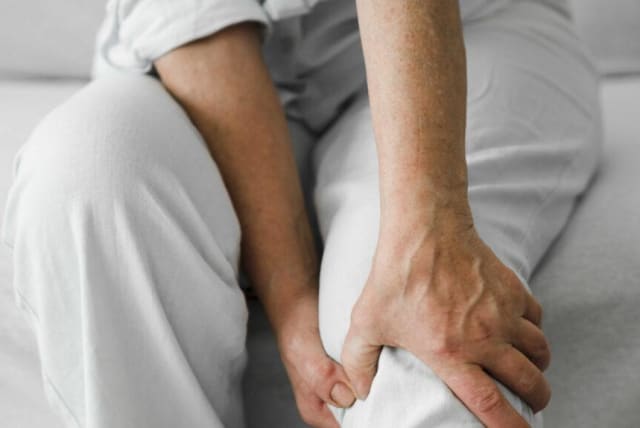8 tips to treat knee pain

Knee pain is common across all age groups, affecting 25% of the population. Discover the triggers, and steps to diagnose it and prevent it from a specialist at Hillel Yaffe Medical Center.
Knee pain stems from diverse factors like age, lifestyle, and underlying medical conditions. A recent Arthritis Care & Research study unveiled that 25% of those aged 50 and above suffer from knee pain, a frequency escalating with age. Even young individuals might grapple with knee pain due to injuries, overuse, or medical conditions.
Knee pain may emanate from various injuries such as sprains, ligament tears like ACL, PCL, LCL, meniscus tears, or fractures. Repetitive exertion in activities like running, jumping, or kneeling could lead to persistent knee pain, instability, and limited movement.
Degenerative arthritis, rheumatoid arthritis, and inflammation also manifest in knee pain and swelling. Conditions like patella tendonitis or bursitis can trigger discomfort through tendon inflammation or irritation.
Pathological anatomy or medical issues like infections, cysts, or tumors can also be the root cause of knee pain.
Methods to mitigate knee pain:
- Strengthen leg muscles: Regular exercises that target knee-surrounding muscles, such as quadriceps and hamstrings, enhance stability, reducing injury risk.
- Pre-exercise warm-up and stretching: Preparing muscles via warm-up improves blood flow and flexibility, aiding injury prevention. Stretching enhances joint mobility.
- Proper technique: Maintain correct posture, form, and body mechanics in sports and exercises. Prevent jerky motions that strain the knee joint.
- Optimal footwear: Well-supported and cushioned shoes absorb shocks, reducing knee pressure during high-impact activities like running and aerobics.
- Moderation: Listen to your body and avoid excessive activities straining the knees. Take regular breaks during exercise.
- Healthy weight: Maintaining a balanced diet and exercise regimen helps control weight, curbing knee joint pressure and injury risk.
- Protective gear: For sports like skiing or soccer with heightened knee injury risk, protective equipment like knee pads is essential.
- Diverse physical activities: Engaging in varied sports prevents overuse injuries from repetitive motions. Cross-training strengthens different muscle groups, supporting the knees.
Knee pain can emerge at any age due to injury, inflammation, infection, or anatomical anomalies. If knee discomfort persists, seeking prompt medical examination for diagnosis and treatment is crucial.
Diagnostic approaches:
Advances in knee injury diagnostics offer comprehensive evaluations using tools like:
- MRI: Powerful magnets and radio waves create detailed knee structure images, detecting ligament, tendon, cartilage, and bone injuries.
- Ultrasound: Real-time sound wave imaging identifies torn ligaments, tendon injuries, and cysts. Useful for guiding interventions.
- CT scan: Cross-sectional knee images aid bone and joint alignment assessment, useful for identifying fractures and complex injuries.
- Arthroscopy: A diagnostic and therapeutic procedure involving a small camera to visualize ligaments, cartilage, and meniscus, aiding injury repair.
- Stress radiographs: X-rays under joint pressure gauge ligament stability, crucial for determining ACL and collateral ligament injury impact.
- Advanced imaging techniques: Dynamic or functional MRI evaluates knee joint under stress, guiding treatment choices with insights on functional stability.
It's important to highlight that while the diagnostic techniques mentioned are indeed advanced and provide valuable information, a thorough assessment by a healthcare professional, such as an orthopedic surgeon, remains fundamental for an accurate diagnosis and the development of an effective treatment plan.
Advanced approaches to treating knee injuries:
- Minimally invasive procedures: Surgical advancements have given rise to minimally invasive methods like arthroscopy. By employing small incisions and a miniature camera, arthroscopic surgery permits visualization and repair of knee joint structures. This approach reduces surgical impact, minimizes scarring, and facilitates swifter recovery compared to traditional open surgery.
- Ligament reconstruction: For severe knee ligament injuries like ACL tears, surgeons typically opt for ligament reconstruction surgery. This procedure entails replacing the damaged ligament with a graft, often employing a portion of the patient's own tendon or a donor graft. Leveraging cutting-edge techniques like double bundle reconstruction and implants can enhance stability and yield better functional outcomes.
- Cartilage repair/restoration: The evolution of advanced techniques offers solutions for restoring damaged knee cartilage. Procedures like microfracture, mosaicplasty, autologous chondrocyte implantation (ACI), and matrix-assisted autologous chondrocyte implantation (MACI) aim to stimulate cartilage regrowth or replace damaged areas. This preserves joint integrity, mitigating the risk of osteoarthritis.
- Meniscus treatment: Meniscus tears, common knee injuries, can be addressed through repair or transplant. Advanced methods, including all-in-one repair and suture techniques, facilitate healing. If repair isn't feasible, a transplant involving a donor meniscus can be considered.
- Biological therapies: Platelet-rich plasma (PRP) and stem cell therapy have emerged as promising options for knee injury treatment. PRP involves injecting a high-growth-factor solution derived from the patient's blood into the affected area, promoting healing and tissue regeneration. Stem cell therapy employs cells with the potential to transform into diverse cell types, aiding tissue restoration and regeneration.
The writer is the director of the Arthroscopy and Sports Injuries Unit, Orthopedic Unit, at Hillel Yaffe Medical Center.
Jerusalem Post Store
`; document.getElementById("linkPremium").innerHTML = cont; var divWithLink = document.getElementById("premium-link"); if (divWithLink !== null && divWithLink !== 'undefined') { divWithLink.style.border = "solid 1px #cb0f3e"; divWithLink.style.textAlign = "center"; divWithLink.style.marginBottom = "15px"; divWithLink.style.marginTop = "15px"; divWithLink.style.width = "100%"; divWithLink.style.backgroundColor = "#122952"; divWithLink.style.color = "#ffffff"; divWithLink.style.lineHeight = "1.5"; } } (function (v, i) { });

